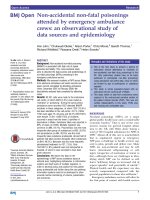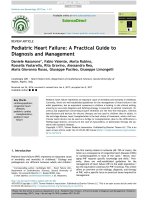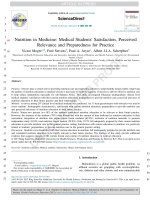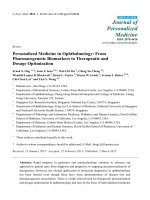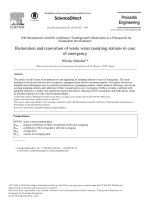Pediatric emergency medicine trisk 2609 2609
Bạn đang xem bản rút gọn của tài liệu. Xem và tải ngay bản đầy đủ của tài liệu tại đây (105.14 KB, 1 trang )
associated with tonic posturing. The episode lasts only a few seconds, and
afterward, the child resumes normal activity. Acute dystonia, usually seen as a
side effect of certain medications, can mimic a tonic seizure. The child having a
dystonic reaction, however, does not lose consciousness and has no postictal
drowsiness.
Several paroxysmal events are associated with sleep. Night terrors (see Chapter
126 Behavioral and Psychiatric Emergencies ) usually begin in the preschool
years. The sleeping child wakes suddenly, is confused and disoriented, and
appears frightened, often screaming and showing signs of increased autonomic
activity (tachycardia, tachypnea, sweating, dilated pupils). Such episodes
typically last only a few minutes, and the child does not usually recall the event.
Benign myoclonus is characterized by self-limited episodes of sudden jerking of
the extremities, usually upon falling asleep. There is no alteration of
consciousness. In sleep paralysis, there is a transient inability to move during the
transition between sleeping and waking, also with no change in the level of
consciousness.
Pseudoseizures are occasionally seen, often in patients with an underlying
seizure disorder or in patients who have a relative with epilepsy. Some features
suggestive of pseudoseizures are suggestibility; lack of coordination of
movements; moaning or talking during the seizure; lack of incontinence,
autonomic changes, or postictal drowsiness; response to painful stimuli; and poor
response to treatment with anticonvulsant agents.
The most important diagnostic test in distinguishing nonepileptic events from
seizures is a careful history, including a detailed description of the event from the
person who witnessed it. In atypical or unclear cases, referral for
electroencephalogram (EEG) or video EEG monitoring may help in establishing
the diagnosis.
Clinically, seizures may be divided into partial (also termed focal) and
generalized seizures ( Table 97.2 ), and partial seizures are further classified as
complex or simple. Complex partial seizures imply impaired consciousness.
Generalized tonic–clonic seizures (previously called grand mal seizures ) are the
type most often seen in acute pediatric care. The onset of generalized tonic–clonic
seizures is usually abrupt, although 20% to 30% of children may experience a
sensory or motor aura. If sitting or standing, the child falls to the ground. The face
becomes pale, the pupils dilate, the eyes deviate upward or to one side, and the
muscles contract. As the increased tone of the thoracic and abdominal muscles
forces air through the glottis, a grunt or cry may be heard. Incontinence of urine
or stool is common. After this brief tonic phase (10 to 30 seconds), clonic
